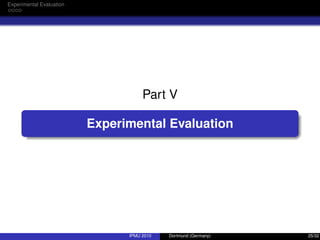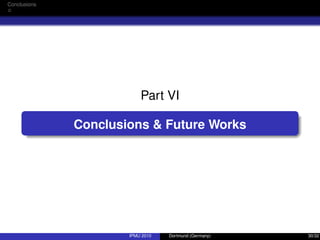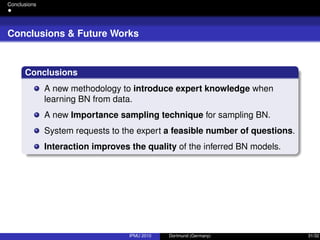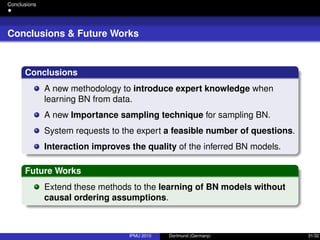An Importance Sampling Approach to Integrate Expert Knowledge When Learning Bayesian Networks From Data
- 1. An Importance sampling approach to integrate expert knowledge when learning Bayesian Networks from data Andrés Cano, Andrés R. Masegosa and Serafín Moral Department of Computer Science and Artificial Intelligence University of Granada (Spain) Dortmund, June 2010 Information Processing and Management of Uncertainty in Knowledge-Based Systems IPMU 2010 Dortmund (Germany) 1/32
- 2. Outline 1 Introduction 2 Learning Bayesian Networks(BN) from data 3 Importance Sampling for learning BN 4 Integration of Expert Knowledge 5 Experimental Evaluation 6 Conclusions & Future Works IPMU 2010 Dortmund (Germany) 2/32
- 3. Introduction Part I Introduction IPMU 2010 Dortmund (Germany) 3/32
- 4. Introduction Bayesian Networks Bayesian Networks Excellent models to graphically represent the dependency structure of the underlying distribution in multivariate domains. The learning from data of this dependency structure in a multivariate problem domain represents a very relevant source of knowledge (direct interactions, conditional independencies...) IPMU 2010 Dortmund (Germany) 4/32
- 5. Introduction Learning Bayesian Networks from Data Uncertainty in Model Selection When learning BNs from data there usually are several models with a high score (high posterior probability given the data). This situation is specially common in problem domains with high number of variables and low sample sizes. IPMU 2010 Dortmund (Germany) 5/32
- 6. Introduction Integration of Expert Knowledge Expert Knowledge In many domain problems expert knowledge is available. The graphical structure of BNs greatly ease the interaction with a human expert: Causal ordering. D-separtion criteria. IPMU 2010 Dortmund (Germany) 6/32
- 7. Introduction Integration of Expert Knowledge Expert Knowledge In many domain problems expert knowledge is available. The graphical structure of BNs greatly ease the interaction with a human expert: Causal ordering. D-separtion criteria. Previous Works I There have been many attempts to introduce expert knowledge when learning BNs from data. Via Prior Distribution [2,5]: Use of specific prior distributions over the possible graph structures to integrate expert knowledge: Expert assigns higher prior probabilities to most likely edges. IPMU 2010 Dortmund (Germany) 6/32
- 8. Introduction Integration of Expert Knowledge Previous Works II Via structural Restrictions [6]: Expert codify his/her knowledge as structural restrictions. Expert defines the existence/absence of arcs and/or edges and causal ordering restrictions. Retrieved model should satisfy these restrictions. IPMU 2010 Dortmund (Germany) 7/32
- 9. Introduction Integration of Expert Knowledge Previous Works II Via structural Restrictions [6]: Expert codify his/her knowledge as structural restrictions. Expert defines the existence/absence of arcs and/or edges and causal ordering restrictions. Retrieved model should satisfy these restrictions. Limitations of "Prior" Expert Knowledge The system would ask to the expert his/her belief about any possible feature of the BN (non feasible in high domains). The expert could be biased to provide the most “easy” or clear knowledge. The system does not help to the user to introduce information about the BN structure. IPMU 2010 Dortmund (Germany) 7/32
- 10. Introduction Interactive Learning of Bayesian Networks IPMU 2010 Dortmund (Germany) 8/32
- 11. Introduction Interactive Learning of Bayesian Networks Active Interaction with the Expert Strategy: Ask to the expert by the presence of the edges that most reduce the model uncertainty. Method: Framework to allow an efficient and effective interaction with the expert. Expert is only asked for this controversial structural features. IPMU 2010 Dortmund (Germany) 8/32
- 12. Previous Knowledge Part II Learning Bayesian Networks from data IPMU 2010 Dortmund (Germany) 9/32
- 13. Previous Knowledge Notation Let be X = (X1, ..., Xn) a set of n random variables. Val(Xi ) is the set of values of Xi . We assume variables are enumerated in a total causal order. We also assume a fully observed data set D. IPMU 2010 Dortmund (Germany) 10/32
- 14. Previous Knowledge Notation Let be X = (X1, ..., Xn) a set of n random variables. Val(Xi ) is the set of values of Xi . We assume variables are enumerated in a total causal order. We also assume a fully observed data set D. A Bayesian Network B can be described by: G the graph structure. θG the parameters. A graph G can be decomposed as a vector of parent sets: G = (Pa(X1), ..., Pa(Xn)) IPMU 2010 Dortmund (Germany) 10/32
- 15. Previous Knowledge Notation Let be X = (X1, ..., Xn) a set of n random variables. Val(Xi ) is the set of values of Xi . We assume variables are enumerated in a total causal order. We also assume a fully observed data set D. A Bayesian Network B can be described by: G the graph structure. θG the parameters. A graph G can be decomposed as a vector of parent sets: G = (Pa(X1), ..., Pa(Xn)) We also define Ui as a random variable taking values in the space of all possible parent sets of Xi , Val(Ui ). Let be G a random variable taking values in the set Val(G) of all possible graph structures consistent with the total order. IPMU 2010 Dortmund (Germany) 10/32
- 16. Previous Knowledge The Bayesian Learning Framework Scoring a graph structure Marginal Likelihood of a graph structure: P(G = G|D) = P(G|D) ∝ P(G)P(D|G) = i score(Xi , PaG(Xi )|D) scoreBDeu(Xi , Ui |D) = Pi (U) |Ui | j=0 Γ(αij ) Γ(αij + Nij ) |Xi | k=1 Γ(αijk + Nijk ) Γ(αijk ) Pi (U) is the prior probability that U is the parent set of Xi . IPMU 2010 Dortmund (Germany) 11/32
- 17. Previous Knowledge The Bayesian Learning Framework Scoring a graph structure Marginal Likelihood of a graph structure: P(G = G|D) = P(G|D) ∝ P(G)P(D|G) = i score(Xi , PaG(Xi )|D) scoreBDeu(Xi , Ui |D) = Pi (U) |Ui | j=0 Γ(αij ) Γ(αij + Nij ) |Xi | k=1 Γ(αijk + Nijk ) Γ(αijk ) Pi (U) is the prior probability that U is the parent set of Xi . Approximating the posterior P(G|D) Our approach is supported on the approximation of P(G|D). It allows to know which graph structures are the most likely (best explain the data). Exhaustive enumeration is not feasible because the space of graph structures is super-exponential. IPMU 2010 Dortmund (Germany) 11/32
- 18. Previous Knowledge Approximating the Posterior Factorization of P(G|D) Assumption of a total order implies that the selection of the parent sets for each Xi are independent among them: P(G|D) = i P(Ui |D) P(G|D) can be decomposed in n independent problems. P(Ui |D) posterior probability of the possible parent sets of variable Xi . Each of the sub-problems still has exponential size. IPMU 2010 Dortmund (Germany) 12/32
- 19. Previous Knowledge Approximating the Posterior P(Ui|D) Closed Form Solution In [3] it was proposed a closed form solution assuming a node can have up to K parents. It would have a polynomial efficiency O(n(K+1)). IPMU 2010 Dortmund (Germany) 13/32
- 20. Previous Knowledge Approximating the Posterior P(Ui|D) Closed Form Solution In [3] it was proposed a closed form solution assuming a node can have up to K parents. It would have a polynomial efficiency O(n(K+1)). Markov Chain Monte Carlo Lets Val(Ui ) be the space model of the Markov Chain. If the Markov Chain is in some state U in iteration t, a new model U is randomly drawn by adding, deleting of switching any edge. The Markov Chain moves to state U in the iteration t + 1 with probability: m(Ut , Ut+1 ) = min{1, N(U)score(D|U ) N(U )score(D|U) } If it not, the Markov Chain remains in state U. This Markov Chain has an stationary distribution (t → ∞) which is P(U|D). IPMU 2010 Dortmund (Germany) 13/32
- 21. Importance Sampling Part III Importance Sampling IPMU 2010 Dortmund (Germany) 14/32
- 22. Importance Sampling Importance Sampling Description Based on the employment of an auxiliary distribution Q which roughly approximate P, the target distribution. Q is a distribution which is easier to sample for it. EP (f(x)) = P(x) Q(x) f(x)Q(x)dx = EQ(w(x)f(x)) (1) where w(x) = P(x) Q(x) acts as a weight function. IPMU 2010 Dortmund (Germany) 15/32
- 23. Importance Sampling Importance Sampling Description Based on the employment of an auxiliary distribution Q which roughly approximate P, the target distribution. Q is a distribution which is easier to sample for it. EP (f(x)) = P(x) Q(x) f(x)Q(x)dx = EQ(w(x)f(x)) (1) where w(x) = P(x) Q(x) acts as a weight function. A set of T samples {x1, ..., xT } are generated form Q and, then, it is computed wt = P(xt ) Q(xt ) . The estimator ˆµ of EP (f(x)) is finally computed as follows: ˆµ = T t=1 w(xt )f(t) T t=1 w(xt ) (2) Key Aspect: P and Q can be known up to a multiplicative constant. IPMU 2010 Dortmund (Germany) 15/32
- 24. Importance Sampling Importance Sampling for learning BNs Step 0: Candidate Parents are considered in a random permutation. Score of initial model: score(X, {∅}|D) IPMU 2010 Dortmund (Germany) 16/32
- 25. Importance Sampling Importance Sampling for learning BNs Step 1: Evaluate C as parent of X. Compute the ratio: r = score(X, {C}|D) score(X, {C}|D) + score(X, {∅}|D) = 0.8 Randomly accept C as parent of X with probability r = 0.8 −→ Accepted. Q = 0.8 IPMU 2010 Dortmund (Germany) 17/32
- 26. Importance Sampling Importance Sampling for learning BNs Step 2: Evaluate B as parent of X. Compute the ratio: r = score(X, {C, B}|D) score(X, {C, B}|D) + score(X, {C}|D) = 0.1 Randomly accept B as parent of X with probability r = 0.1 −→ Non Accepted. Q = 0.8 · 0.9 IPMU 2010 Dortmund (Germany) 18/32
- 27. Importance Sampling Importance Sampling for learning BNs Step 3: Evaluate A as parent of X. Compute the ratio: r = score(X, {C, A}|D) score(X, {C, A}|D) + score(X, {C}|D) = 0.7 Randomly accept A as parent of X with probability r = 0.7 −→ Accepted. Q = 0.8 · 0.9 · 0.7 = 0.504 Weight of the final model: W1 = score(X, {C, A}|D) 0.504 IPMU 2010 Dortmund (Germany) 19/32
- 28. Importance Sampling Importance Sampling for learning BNs Step 3: Evaluate A as parent of X. Compute the ratio: r = score(X, {C, A}|D) score(X, {C, A}|D) + score(X, {C}|D) = 0.7 Randomly accept A as parent of X with probability r = 0.7 −→ Accepted. Q = 0.8 · 0.9 · 0.7 = 0.504 Weight of the final model: W1 = score(X, {C, A}|D) 0.504 The process is repeated T times. Using these samples we get an approximation of P(Ui |D). IPMU 2010 Dortmund (Germany) 19/32
- 29. Integrating Expert Knowledge Part IV Integrating Expert Knowledge IPMU 2010 Dortmund (Germany) 20/32
- 30. Integrating Expert Knowledge Methodology Description IPMU 2010 Dortmund (Germany) 21/32
- 31. Integrating Expert Knowledge Prior Knowledge Representing absence of prior knowledge “Uniform prior over structures is usually chosen by convenience” [3]. P(G) does not grow with the data, but it matters at low sample sizes. IPMU 2010 Dortmund (Germany) 22/32
- 32. Integrating Expert Knowledge Prior Knowledge Representing absence of prior knowledge “Uniform prior over structures is usually chosen by convenience” [3]. P(G) does not grow with the data, but it matters at low sample sizes. Let us assume that the prior probability of an edge is p and independent of each other. If Xi has k parents out of m nodes: P(Pa(Xi )) = pk (1 − p)(m−k) If the number of candidate parents m grows, p should be decreased to control de number of false positives edges: “multiplicity correction”. IPMU 2010 Dortmund (Germany) 22/32
- 33. Integrating Expert Knowledge Prior Knowledge Representing absence of prior knowledge “Uniform prior over structures is usually chosen by convenience” [3]. P(G) does not grow with the data, but it matters at low sample sizes. Let us assume that the prior probability of an edge is p and independent of each other. If Xi has k parents out of m nodes: P(Pa(Xi )) = pk (1 − p)(m−k) If the number of candidate parents m grows, p should be decreased to control de number of false positives edges: “multiplicity correction”. This is solved by assuming that p has a Beta prior with parameter α = 0.5 [11]: Pi (Pa(Xi )) = Γ(2 ∗ α) Γ(m + 2α) Γ(k + α)Γ(m − k + α) Γ(α)Γ(α) IPMU 2010 Dortmund (Germany) 22/32
- 34. Integrating Expert Knowledge Interacting with the Expert Description Key Idea: As lower the entropy of P(Ui |D) is, more reliable learning we have. Expert Interaction is carried out in order to reduce the entropy H(P(Ui |D)). . IPMU 2010 Dortmund (Germany) 23/32
- 35. Integrating Expert Knowledge Interacting with the Expert P(S → X|D) = 0.85 P(R → X|D) = 0.8 P(C → X|D) = 0.45 Description Key Idea: As lower the entropy of P(Ui |D) is, more reliable learning we have. Expert Interaction is carried out in order to reduce the entropy H(P(Ui |D)). System ask to the expert by those edges with higher entropy. IPMU 2010 Dortmund (Germany) 23/32
- 36. Integrating Expert Knowledge Interacting with the Expert P(S → X|D) = 0.88 P(R → X|D) = 0.77 P(C → X|D) = 1.0 Description The entropy of P(Ui |D) is reduced. Probability mass concentrates around one model. This methodology can be iteratively applied asking by the presence/absence of more edges. Stopping the interaction when the probability of MAP model is L times higher the second most probable model. IPMU 2010 Dortmund (Germany) 24/32
- 37. Experimental Evaluation Part V Experimental Evaluation IPMU 2010 Dortmund (Germany) 25/32
- 38. Experimental Evaluation Experimental Set-up Bayesian Networks: alarm (37 nodes), boblo (23 nodes), boerlage-92 (23 nodes), hailfinder (56 nodes), insurance (27 nodes). Sample Sizes: We run 10 times the algorithms with different samples sizes: 50, 100, 500 and 1000. IPMU 2010 Dortmund (Germany) 26/32
- 39. Experimental Evaluation Experimental Set-up Bayesian Networks: alarm (37 nodes), boblo (23 nodes), boerlage-92 (23 nodes), hailfinder (56 nodes), insurance (27 nodes). Sample Sizes: We run 10 times the algorithms with different samples sizes: 50, 100, 500 and 1000. Evaluation Measures Number of missing/extra links, Kullback-Leibler distance... We report average values across the five networks. Expert Interaction is simulated: Access to the true BN model when asking by presence/absence of an edge. IPMU 2010 Dortmund (Germany) 26/32
- 40. Experimental Evaluation Structure Prior Evaluation N. of Structural Errors KL Distance Analysis Beta-Prior reduces the number of structural errors for both IS and MCMCM. IS has a low number of errors than MCMC specially with low sample sizes. Beta-Prior also reduces KL distance for both IS and MCMC. IPMU 2010 Dortmund (Germany) 27/32
- 41. Experimental Evaluation Expert Interaction Evaluation N. of Structural Errors KL Distance Analysis As much the mass of the posterior probability is concentrated around one model, the lower is the number of structural errors. The KL distance does not significantly improve with large sample sizes (these structural errors do not have great impact in the prediction capacity). IPMU 2010 Dortmund (Germany) 28/32
- 42. Experimental Evaluation Expert Interaction Evaluation N. of Interactions Interaction Accuracy Analysis The number of Interactions are feasible for a human expert. Prior Exhaustive Querying: 600 questions in averaged. The Interaction Accuracy: ratio between number of reduced structural errors and number of interactions. Average Accuracy of random interactions: 1%. IPMU 2010 Dortmund (Germany) 29/32
- 43. Conclusions Part VI Conclusions & Future Works IPMU 2010 Dortmund (Germany) 30/32
- 44. Conclusions Conclusions & Future Works Conclusions A new methodology to introduce expert knowledge when learning BN from data. A new Importance sampling technique for sampling BN. System requests to the expert a feasible number of questions. Interaction improves the quality of the inferred BN models. IPMU 2010 Dortmund (Germany) 31/32
- 45. Conclusions Conclusions & Future Works Conclusions A new methodology to introduce expert knowledge when learning BN from data. A new Importance sampling technique for sampling BN. System requests to the expert a feasible number of questions. Interaction improves the quality of the inferred BN models. Future Works Extend these methods to the learning of BN models without causal ordering assumptions. IPMU 2010 Dortmund (Germany) 31/32
- 46. Thanks for your attention!! Questions? IPMU 2010 Dortmund (Germany) 32/32







![Introduction
Integration of Expert Knowledge
Expert Knowledge
In many domain problems expert knowledge is available.
The graphical structure of BNs greatly ease the interaction with a human expert:
Causal ordering.
D-separtion criteria.
Previous Works I
There have been many attempts to introduce expert knowledge when learning
BNs from data.
Via Prior Distribution [2,5]: Use of specific prior distributions over the
possible graph structures to integrate expert knowledge:
Expert assigns higher prior probabilities to most likely edges.
IPMU 2010 Dortmund (Germany) 6/32](https://image.slidesharecdn.com/slides-intercativelearning-ipmu-151124194045-lva1-app6891/85/An-Importance-Sampling-Approach-to-Integrate-Expert-Knowledge-When-Learning-Bayesian-Networks-From-Data-7-320.jpg)
![Introduction
Integration of Expert Knowledge
Previous Works II
Via structural Restrictions [6]: Expert codify his/her knowledge as structural
restrictions.
Expert defines the existence/absence of arcs and/or edges and causal
ordering restrictions.
Retrieved model should satisfy these restrictions.
IPMU 2010 Dortmund (Germany) 7/32](https://image.slidesharecdn.com/slides-intercativelearning-ipmu-151124194045-lva1-app6891/85/An-Importance-Sampling-Approach-to-Integrate-Expert-Knowledge-When-Learning-Bayesian-Networks-From-Data-8-320.jpg)
![Introduction
Integration of Expert Knowledge
Previous Works II
Via structural Restrictions [6]: Expert codify his/her knowledge as structural
restrictions.
Expert defines the existence/absence of arcs and/or edges and causal
ordering restrictions.
Retrieved model should satisfy these restrictions.
Limitations of "Prior" Expert Knowledge
The system would ask to the expert his/her belief about any possible feature
of the BN (non feasible in high domains).
The expert could be biased to provide the most “easy” or clear knowledge.
The system does not help to the user to introduce information about the BN
structure.
IPMU 2010 Dortmund (Germany) 7/32](https://image.slidesharecdn.com/slides-intercativelearning-ipmu-151124194045-lva1-app6891/85/An-Importance-Sampling-Approach-to-Integrate-Expert-Knowledge-When-Learning-Bayesian-Networks-From-Data-9-320.jpg)




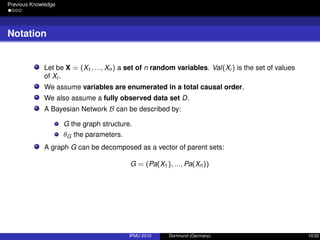




![Previous Knowledge
Approximating the Posterior P(Ui|D)
Closed Form Solution
In [3] it was proposed a closed form solution assuming a node can have up to
K parents.
It would have a polynomial efficiency O(n(K+1)).
IPMU 2010 Dortmund (Germany) 13/32](https://image.slidesharecdn.com/slides-intercativelearning-ipmu-151124194045-lva1-app6891/85/An-Importance-Sampling-Approach-to-Integrate-Expert-Knowledge-When-Learning-Bayesian-Networks-From-Data-19-320.jpg)
![Previous Knowledge
Approximating the Posterior P(Ui|D)
Closed Form Solution
In [3] it was proposed a closed form solution assuming a node can have up to
K parents.
It would have a polynomial efficiency O(n(K+1)).
Markov Chain Monte Carlo
Lets Val(Ui ) be the space model of the Markov Chain.
If the Markov Chain is in some state U in iteration t, a new model U is
randomly drawn by adding, deleting of switching any edge.
The Markov Chain moves to state U in the iteration t + 1 with probability:
m(Ut
, Ut+1
) = min{1,
N(U)score(D|U )
N(U )score(D|U)
}
If it not, the Markov Chain remains in state U.
This Markov Chain has an stationary distribution (t → ∞) which is P(U|D).
IPMU 2010 Dortmund (Germany) 13/32](https://image.slidesharecdn.com/slides-intercativelearning-ipmu-151124194045-lva1-app6891/85/An-Importance-Sampling-Approach-to-Integrate-Expert-Knowledge-When-Learning-Bayesian-Networks-From-Data-20-320.jpg)









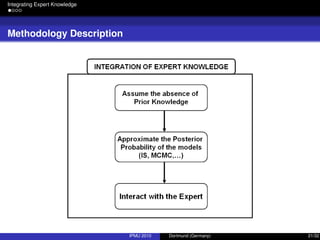
![Integrating Expert Knowledge
Prior Knowledge
Representing absence of prior knowledge
“Uniform prior over structures is usually chosen by convenience” [3].
P(G) does not grow with the data, but it matters at low sample sizes.
IPMU 2010 Dortmund (Germany) 22/32](https://image.slidesharecdn.com/slides-intercativelearning-ipmu-151124194045-lva1-app6891/85/An-Importance-Sampling-Approach-to-Integrate-Expert-Knowledge-When-Learning-Bayesian-Networks-From-Data-31-320.jpg)
![Integrating Expert Knowledge
Prior Knowledge
Representing absence of prior knowledge
“Uniform prior over structures is usually chosen by convenience” [3].
P(G) does not grow with the data, but it matters at low sample sizes.
Let us assume that the prior probability of an edge is p and independent of
each other. If Xi has k parents out of m nodes:
P(Pa(Xi )) = pk
(1 − p)(m−k)
If the number of candidate parents m grows, p should be decreased to
control de number of false positives edges: “multiplicity correction”.
IPMU 2010 Dortmund (Germany) 22/32](https://image.slidesharecdn.com/slides-intercativelearning-ipmu-151124194045-lva1-app6891/85/An-Importance-Sampling-Approach-to-Integrate-Expert-Knowledge-When-Learning-Bayesian-Networks-From-Data-32-320.jpg)
![Integrating Expert Knowledge
Prior Knowledge
Representing absence of prior knowledge
“Uniform prior over structures is usually chosen by convenience” [3].
P(G) does not grow with the data, but it matters at low sample sizes.
Let us assume that the prior probability of an edge is p and independent of
each other. If Xi has k parents out of m nodes:
P(Pa(Xi )) = pk
(1 − p)(m−k)
If the number of candidate parents m grows, p should be decreased to
control de number of false positives edges: “multiplicity correction”.
This is solved by assuming that p has a Beta prior with parameter α = 0.5 [11]:
Pi (Pa(Xi )) =
Γ(2 ∗ α)
Γ(m + 2α)
Γ(k + α)Γ(m − k + α)
Γ(α)Γ(α)
IPMU 2010 Dortmund (Germany) 22/32](https://image.slidesharecdn.com/slides-intercativelearning-ipmu-151124194045-lva1-app6891/85/An-Importance-Sampling-Approach-to-Integrate-Expert-Knowledge-When-Learning-Bayesian-Networks-From-Data-33-320.jpg)



